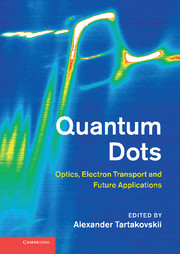Book contents
- Frontmatter
- Contents
- List of contributors
- Preface
- Part I Nanostructure design and structural properties of epitaxially grown quantum dots and nanowires
- Part II Manipulation of individual quantum states in quantum dots using optical techniques
- Part III Optical properties of quantum dots in photonic cavities and plasmon-coupled dots
- Part IV Quantum dot nano-laboratory: magnetic ions and nuclear spins in a dot
- Part V Electron transport in quantum dots fabricated by lithographic techniques from III–V semiconductors and graphene
- 15 Electrically controlling single spin coherence in semiconductor nanostructures
- 16 Theory of electron and nuclear spins in III–V semiconductor and carbon-based dots
- 17 Graphene quantum dots: transport experiments and local imaging
- Part VI Single dots for future telecommunications applications
- Index
- References
17 - Graphene quantum dots: transport experiments and local imaging
from Part V - Electron transport in quantum dots fabricated by lithographic techniques from III–V semiconductors and graphene
Published online by Cambridge University Press: 05 August 2012
- Frontmatter
- Contents
- List of contributors
- Preface
- Part I Nanostructure design and structural properties of epitaxially grown quantum dots and nanowires
- Part II Manipulation of individual quantum states in quantum dots using optical techniques
- Part III Optical properties of quantum dots in photonic cavities and plasmon-coupled dots
- Part IV Quantum dot nano-laboratory: magnetic ions and nuclear spins in a dot
- Part V Electron transport in quantum dots fabricated by lithographic techniques from III–V semiconductors and graphene
- 15 Electrically controlling single spin coherence in semiconductor nanostructures
- 16 Theory of electron and nuclear spins in III–V semiconductor and carbon-based dots
- 17 Graphene quantum dots: transport experiments and local imaging
- Part VI Single dots for future telecommunications applications
- Index
- References
Summary
Introduction
This chapter gives an overview of our recent experimental research on graphene quantum dots. We will focus on two aspects, namely transport experiments revealing the existence of excited states and how they can be used to detect the electron–hole crossover and scanninggate microscopy to reveal local information on localized states.
One of the extraordinary properties of carbon atoms is the ability to be synthesized into solid structures of any dimensionality: three-dimensional graphite and diamond, one-dimensional carbon nanotubes, and zero-dimensional fullerenes. Graphene, a twodimensional carbon allotrope, was the last to be added to this list in 2004, when K. Novoselov et al. published their results [32]. Graphene has been stimulating the physicists' imagination since then: remarkable mechanical and electronic properties make it a promising candidate for future technological advances and breakthroughs in fundamental research [10]. In particular, the linear dispersion relation of graphene (for small energies) and an additional degree of freedom due to the valley degeneracy led to new physics not observed before in a condensed-matter environment. In fact, impressive results on the so-called unconventional quantum Hall effect [33, 55] and Klein tunneling [54] were obtained. The significance of the discovery of graphene and the first experiments were acknowledged and the discoverers of graphene were rewarded the Nobel Prize in physics 2010.
It was not obvious from the very beginning of graphene research whether it is easily possible to build more complex nanostructures like quantum point contacts or quantum dots (QDs).
- Type
- Chapter
- Information
- Quantum DotsOptics, Electron Transport and Future Applications, pp. 296 - 316Publisher: Cambridge University PressPrint publication year: 2012



